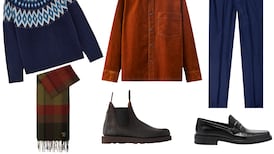STYLE COUNSEL:While many people would love to look half their age, IAN MCCOURTgot so tired of being mistaken for a teen that he sought advice on how to dress in a more mature way
‘HOW MUCH TO Bray?” I ask. I take out one ear phone in the hope that I’ve heard his response incorrectly. Surely he wouldn’t ask me that. Would he? I’m 28. Why would he ask that? Look, be calm. Repeat your question. You’re 28 for God’s sake. He wouldn’t ask that. There’s a girl sitting down on the right. She is listening intently.
“How much to Bray?” I ask again. He repeats the question. My face goes an unimaginable shade of red. “Are you under 16?” he asks.
I’d like to say that this was the first time something like this happened but it’s not. In school, my friends would come in on a Monday morning regaling me with stories of their night out in the pub. I’d sit there quietly, desperately hoping to grow some form of stubble so I could sail nonchalantly past the bouncer without being refused entry. While I cannot change my appearance – or at least I can’t afford the surgery to change it – I haven’t been helped by my choice of clothes. Every day for the past 10 years, it has been the same: hoodie, T-shirt, jeans and Converse. Hoodie, T-shirt, jeans and Converse. Hoodie, T-shirt, jeans and Converse. The cycle has only been broken by the occasional wedding, checked shirt or job interview. Looking around I can see I am not the only man stuck dressing the same way I did 10 years ago, but why?
“Irish men are very conservative and prefer a safer image. They prefer to err on the side of caution. Deep down, a lot of them would like to change but they’re afraid to experiment,” says Mary Holmes, founder and managing director of Ruby Seven Image Consulting.
The moment of clarity on the bus allowed me to step outside myself and made me understand the need to look more grown-up and to break my fashion cycle. It is also the reason why Holmes is standing in my bedroom. My normally impeccably ordered room is awash with jumpers, shirts, T-shirts and trousers that Holmes has decided I need to be rid of.
Gone is my treasured, faded CBGG T-shirt. Gone are the skinny jeans. Gone is my favourite old blue hoodie. My mouth is open at the swiftness of Mary’s destruction. She smiles, surveys the room and looks happy with her work.
Holmes’ work is divided into two. The first part is the consultation process. This involves asking questions about your dressing habits: “Your wardrobe should be based on your life.” Determining your body shape: “You’ve a classic ectomorph profile” (ie, I’m a beanpole). And deciding what colours suit you: I’m autumnal, apparently. The second part is the hard bit: the shopping. Even when you disregard stereotypes, few men really enjoy shopping. It’s a chore worse than housework. Our first stop is Ted Baker on Grafton Street. Holmes zips around the shop picking up stuff for me to try on. Leather jackets, wine, floral-pattern shirts, blazers, double-breasted cardigans, loose dark jeans and fancy shoes: clothes that I would never dream of wearing. She dresses me for work and for going out. Both outfits, while not a million miles from what I’m used to wearing, have pushed me out of my comfort zone making me look older, more mature and, dare I say it, even a bit sophisticated. “Where’s that damn bus driver now?” I wonder.
With the recession in full flow, the Ted Baker prices won’t be to everyone’s liking – most stuff is the wrong side of €100. When I make this point to Holmes she introduces me to the fashion formula that is cost per wear – take the cost of the item and divide it by the number of times you will wear it.
She says that men should adopt this policy for “investing in a few key pieces like jackets and good quality jeans that won’t go out of style”. You pay now, but it lasts a while. “It’s a good way of saving money in the long term,” she says.
Our next stop is River Island. Holmes reckons I can get the same look without the robust price tag. The procedure is the same as in Ted Baker. And the results are the same too. The only exception is the price. A leather jacket in Ted Baker is €415 and €80 in River Island. Jeans cost €115 in one shop and €70 in the other. Cardigans are €115 in Ted Baker and €35 in River Island. The quality is not the same but the financial benefits make these a smart short-term option.
The shopping takes two hours and it’s a relief to be out on the cold of the street rather than cooped up in the stale heat of a changing room. But it’s time well spent. Not only has Holmes managed to brake my Sisyphean-styled fashion cycle, she has managed to do it on the cheap too. For those men stuck in a rut, without a girlfriend or wife to shop for them, this service can show you a new way and save you money.











